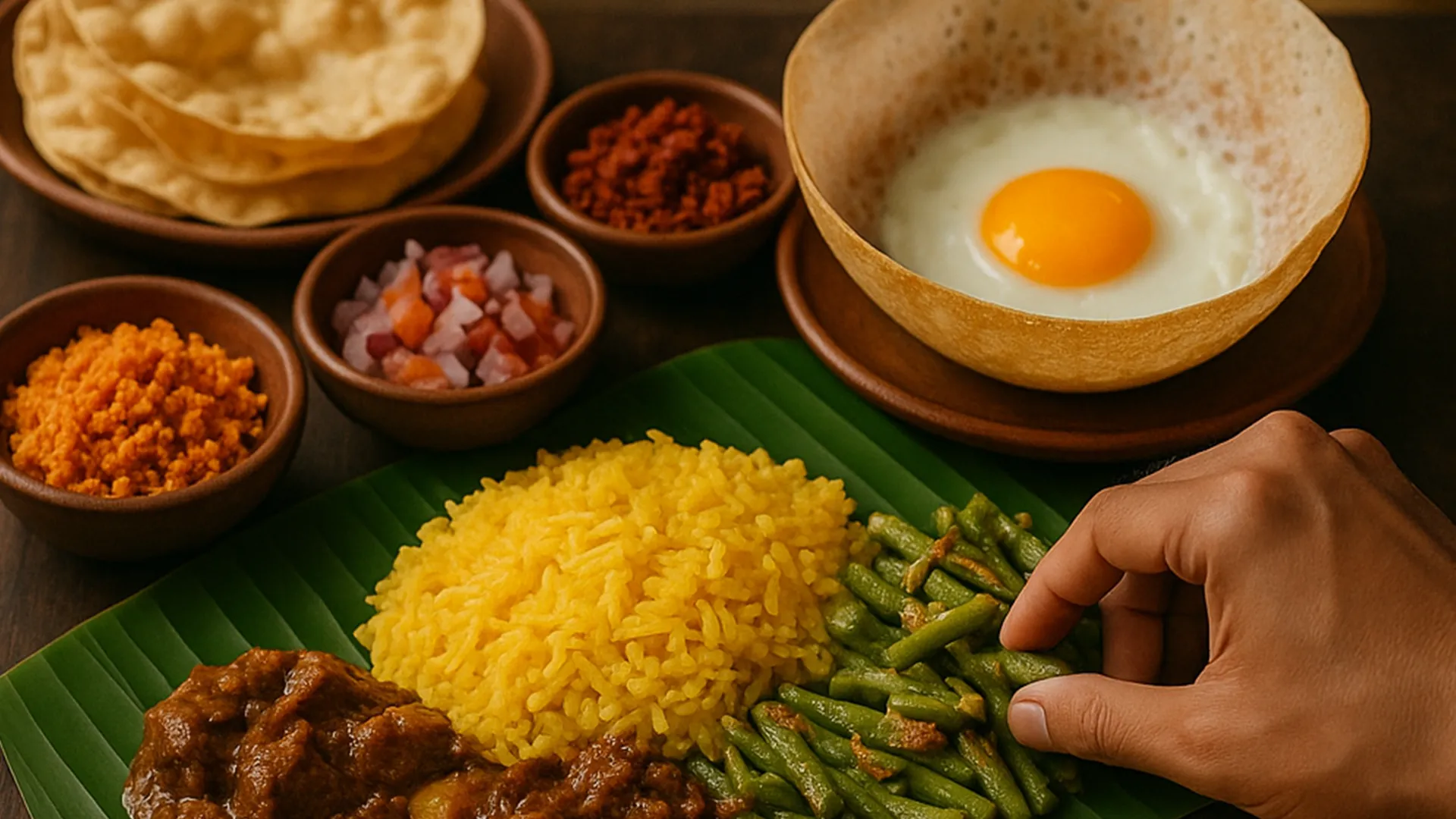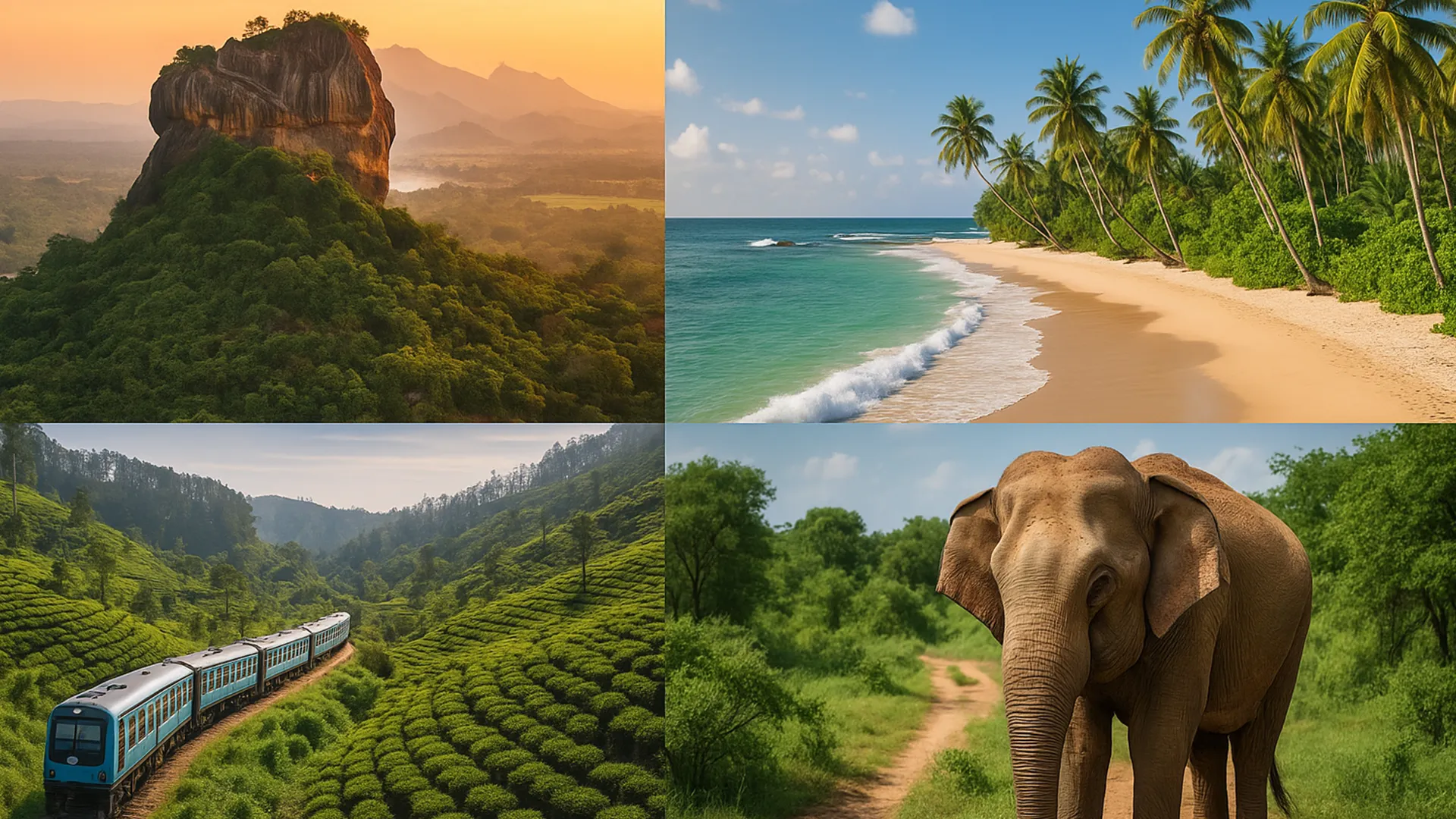
For many, the word "hotel food" conjures images of generic, lukewarm buffets designed to cater to the lowest common denominator. In Sri Lanka, however, this concept is delightfully upended. Here, your hotel is often the gateway to an authentic, vibrant, and complex culinary journey. The island’s cuisine is a bold, aromatic symphony of flavors, and many accommodations have embraced it, moving far beyond the standard toast and eggs to offer a genuine taste of local life.
The cornerstone of any Sri Lankan food experience is the mighty "Rice and Curry." This is not a single dish but a grand ensemble, a daily celebration of flavor and texture. At its best in smaller guesthouses and family-run hotels, this meal is a revelation. A generous mound of fluffy white rice is surrounded by a constellation of small bowls, each containing a different curry. There will be a dhal (lentil) curry, a deeply comforting and spiced staple. You’ll find a devilled dish - perhaps chicken or fish - tossed in a sweet, spicy, and tangy sauce with chunks of onion and bell pepper. A "mallum" or "sambol" will provide a fresh, sharp contrast; perhaps a pol sambol, a fiery mix of grated coconut, red onion, lime juice, and chili, or a gotu kola sambol, an earthy, finely chopped herbal salad. There will be a fried papadum for crunch and a sweet, tangy chutney made from fruits like mango or ambarella. This is not a meal you eat quickly; it’s an experience to be explored, each combination of flavors creating a new bite. The beauty of having this at your hotel is the ability to ask your host about each component, learning the stories behind the food.
Of course, the international traveler is also catered to with impeccable skill. The buffets at larger resorts, especially along the west coast, are feasts of incredible variety. Alongside the Sri Lankan specialties, you might find fresh seafood grills where you can choose your catch of the day, Italian pasta stations, Chinese wok dishes, and decadent dessert tables. This is where the island’s history as a trading port comes to life on a plate. The key is to use the buffet as a sampler platter - a chance to try a little bit of everything. Don't miss the hoppers (appa), bowl-shaped, lacy fermented rice flour pancakes, often served with a fried egg in the center and a side of spicy sambol. For breakfast, this is a quintessential Sri Lankan experience no hotel guest should skip.
A beautiful trend sweeping across Sri Lankan hotels is the farm-to-table experience. Especially prevalent in the hill country and eco-lodges, this concept connects your plate directly to the land. You might dine on vegetables harvested from the hotel’s own organic garden that morning, or enjoy fruit from the trees shading your balcony. This not only guarantees breathtaking freshness but also dramatically reduces the environmental footprint of your meal. It’s a powerful way to taste the true, unadulterated flavor of a green bean, a carrot, or a tomato, reminding you of the deep agricultural roots of the island.
For those with dietary restrictions, Sri Lanka is a surprisingly accommodating destination. The long-standing Buddhist and Hindu traditions mean vegetarianism is widely understood and respected. Many curries are naturally plant-based, and chefs are usually happy to adapt. Vegan travelers will also find a wealth of options, from jackfruit curries to coconut milk-based desserts. The abundance of fresh fruit - from tiny sweet bananas to juicy pineapples and magnificent mangosteens - means healthy, delicious options are always available. The key is communication; don’t hesitate to have a friendly chat with the hotel staff about your needs. Their inherent hospitality means they will often go out of their way to prepare something special for you.
Ultimately, dining at your Sri Lankan hotel is an integral part of the cultural immersion. It’s an opportunity to be adventurous, to ask questions, and to engage all your senses. From the fiery kick of a perfect curry to the sweet end of a creamy buffalo yogurt with treacle, your meals will form a vivid and delicious layer of memory. So move beyond the familiar, skip the plain toast, and dive fork-first into the incredible culinary world that your Sri Lankan hotel is waiting to share with you.
Powered by Froala Editor
Related Insights & Articles

September 18th 2025
The Island's Rhythm: A First-Timer's Guide to Navigating Sri Lanka's Diverse Climates and Cultures
Sri Lanka seems to exist in a thousand different worlds at once. One day you’re sweltering on a sun-drenched beach, the next you’re reaching for a jacket in the misty highlands. You can be exploring the ruins of an ancient civilization in the morning and watching blue whales in the afternoon. This incredible diversity is its greatest attraction, but it can also be a puzzle for first-time visitors. Understanding the island’s rhythmic cycles - of weather, culture, and geography - is the key to crafting a seamless and deeply rewarding journey.
The most decisive factor in planning your trip is the monsoon. Unlike a single rainy season, Sri Lanka has two, blessing it with a year-round tropical climate but dictating which coast is sunny when. From roughly May to September, the southwest monsoon brings rain to the west and south coasts (e.g., Colombo, Galle, Hikkaduwa, Mirissa) while the east coast (Trincomalee, Arugam Bay) enjoys its dry, sunny season. This pattern flips from October to April, when the northeast monsoon dampens the east, and the west and south coast bask in glorious sunshine. The hill country and cultural triangle can be visited year-round, though afternoon showers are common. The secret is not to fear the monsoon. The rains often come in short, intense bursts, followed by brilliant sunshine. The landscape is at its most lush and vibrant, the crowds are thinner, and the air is clean and fresh.
This climatic split makes Sri Lanka a fantastic destination for a two-centre holiday. A perfect two-week itinerary for a first-time visitor, planned around the weather, could begin with the cultural highlights. Fly into Colombo and immediately head to the Cultural Triangle. Spend three or four days exploring the awe-inspiring ancient cities of Anuradhapura and Polonnaruwa, the rock fortress of Sigiriya, and the cave temples of Dambulla. This is where you’ll delve deep into Sri Lanka’s 2,500-year-old Buddhist history. From there, take one of the world’s most scenic train rides into the Hill Country. The journey from Kandy to Ella is an attraction in itself, chugging through tea plantations, past waterfalls, and through misty mountains. Spend a few days in Ella hiking Little Adam’s Peak and Ella Rock, touring a tea factory, and enjoying the cooler climate.
Then, descend from the hills to the coast. Depending on the season, you’ll choose your beach destination. If it’s the dry season on the south coast, head to Mirissa or Unawatuna for whale watching, surfing lessons, and pure relaxation on golden sands. If it’s the East Coast’s time to shine, make the journey to Arugam Bay for a more laid-back, rustic vibe and world-class surfing. This balance gives you the perfect mix of activity and relaxation, culture and nature, all within a compact island.
Weaving through all of this is the warmth of the Sri Lankan people. The culture is a beautiful tapestry of different ethnicities and religions - Sinhalese, Tamil, Muslim, and Burgher - living together. You’ll see Buddhist temples, Hindu kovils, Islamic mosques, and Christian churches, often in proximity. This diversity is reflected in the incredible food, from fiery Sinhalese curries to hearty Tamil meals and delicious Muslim short eats. As a visitor, you are greeted with a genuine, open-hearted hospitality that is rare in the world. A smile is always returned. Don’t be surprised if you’re invited to a local home for tea or offered help without even asking for it.
The rhythm of Sri Lanka is one of beautiful contrasts. It’s the frantic energy of a Colombo market and the profound peace of an ancient temple. It’s the cool silence of the highlands and the powerful roar of the ocean. It’s the spice-infused aroma of a curry and the simple sweetness of a tropical fruit. To navigate it is to embrace this variety. Pack for every occasion, plan around the sun and rain, move between the sacred and the scenic, and most importantly, leave room in your itinerary for the unexpected moments of connection that will truly define your journey. Sri Lanka doesn’t just show you its sights; it invites you into its rhythm, and once you find it, it’s a rhythm you’ll carry with you long after you’ve left its shores.
Powered by Froala Editor

September 18th 2025
Traveling with Tribe: A Family Guide to Sri Lankan Hotels & Resorts
Sri Lanka, with its compact size, friendly locals, and incredible variety of activities, is a secret superhero of family travel. It’s a country where a child’s imagination can run wild, picturing elephants on safari, exploring ancient fortress ruins, and splashing in warm ocean waves. But the success of any family holiday often hinges on one crucial element: the home base. Choosing the right hotel or resort can transform a good trip into an unforgettable one, for both parents and kids alike.
The first and most important decision is location. For families with younger children, the calmer, shallow waters of the southwest coast, like those in Bentota, Kalutara, or Wadduwa, are ideal. These beaches provide a safe environment for paddling and building sandcastles, and the resorts here are well-versed in catering to families. For those with older, more adventurous kids, the cultural triangle (Sigiriya, Dambulla, Polonnaruwa) offers a thrilling immersion into history and wildlife. Wandering through ancient kingdoms and going on safari to see elephants, leopards, and sloth bears is like stepping into a living history and geography book. The hill country, with its train rides through tea plantations and cooler climate, offers a completely different, but equally enchanting, experience.
Once you’ve chosen your region, the room configuration is your next priority. The classic hotel room with two double beds often works, but for more space and privacy, seeking out family suites or interconnected rooms is a game-changer. This allows parents to have their own space after the kids are asleep, creating a semblance of a normal evening. For larger families or those seeking a truly special experience, private villas are a magnificent option. Many villas come with their own small private pool, a living area, and often, the invaluable services of a cook and butler. This allows for flexible meal times, the ability to prepare familiar snacks for fussy eaters, and a contained, safe environment for children to play.
The amenities within the hotel grounds are what truly define a family-friendly stay. A swimming pool is non-negotiable. After a day of sightseeing in the heat, a pool is the ultimate reward for kids and a place for them to burn off excess energy. Look for resorts with dedicated children’s pools or shallow areas. A kids’ club can be a welcome respite for parents, offering supervised activities like mask painting, coconut leaf weaving, or Sri Lankan drum lessons, giving children a fun cultural experience while adults enjoy a quiet meal or a spa treatment. Evenings can be magical, with many hotels organizing family-friendly events like movie nights under the stars or bonfires on the beach.
The adventure doesn’t stop at the hotel gate. Sri Lanka is packed with activities that captivate all ages. A safari in Udawalawe or Yala National Park is an absolute highlight, a real-life jungle book experience. Visiting the Pinnawala Elephant Orphanage, where you can watch dozens of elephants bathe in the river, is a sight that will stay with children forever. For a dose of culture, the ancient rock fortress of Sigiriya is a thrilling climb for older kids (with plenty of stops along the way), while the Dambulla Cave Temples, with their myriad Buddha statues, inspire awe. The key is to balance activity with downtime, ensuring everyone has enough energy and isn’t overwhelmed.
Practicalities are paramount. When booking, don’t hesitate to ask the hotel specific questions. Can they provide baby cots? Do they have high chairs in the restaurant? Is it possible to arrange for a babysitter? Sri Lankan people have a natural affinity for children, and staff are typically incredibly helpful and accommodating. Preparing a small first-aid kit with plasters, antiseptics, and stomach upset remedies is always wise. Finally, embrace the flexibility that a family trip requires. Some of the best memories will be unplanned: stopping for a fresh pineapple from a roadside stall, playing a game of cricket with local kids on the beach, or simply enjoying the slow, shared rhythm of a day together in a beautiful new place. Sri Lanka’s warmth extends beyond its climate, making it the perfect place to create those cherished family travel stories.
Powered by Froala Editor

September 18th 2025
From Kooks to Kahunas: What to Really Expect at Your First Surf Camp in Arugam Bay
So, you’ve decided to take the plunge. You’ve seen the photos of perfect, peeling waves and sun-drenched beaches, and you’ve booked your spot at a surf camp in Arugam Bay, Sri Lanka’s legendary point break Mecca. Excitement is high, but so might be a little nervousness. What does a day in the life of a surf novice in this surfer’s paradise actually look like? Leave your expectations at the door and get ready for a journey that is equal parts challenging, hilarious, and ultimately, incredibly rewarding.
Your first day will likely begin with a mixture of anticipation and jet lag. Arugam Bay is not a bustling city; it’s a long, lazy strip of sand backed by dusty roads, cozy cafes, and guesthouses nestled among the palms. The vibe is immediately laid-back. You’ll meet your instructors - often deeply tanned, endlessly patient local surfers who have spent their lives in this water. They’ve seen every kind of "kook" (an affectionate term for a beginner) and know exactly how to guide you. The first lesson, crucially, is on land. You’ll be on your board in the sand, practicing the pop-up. It looks simple when they do it. It feels anything but when you try. You’ll wobble, you’ll put your hands in the wrong place, and you’ll probably collapse in a heap of laughter. This is all part of the process. This repetition is building muscle memory that will, eventually, kick in when you’re in the water.
Then comes the moment of truth. You’ll carry your soft-top board (which suddenly feels enormous) into the warm, bath-like Indian Ocean. At a beginner-friendly spot like Peanut Farm or Pottuvil Point, the water is often waist-deep and the waves are small and crumbly, perfect for learning. Your instructor will be right there with you, guiding you onto waves. The initial feeling is one of controlled chaos. There’s the frantic paddling as they yell “Go! Go! Go!”, the sudden feeling of the wave catching the board, and then the frantic scramble to remember everything you practiced on the beach. Your first successful stand-up is a lightning bolt of euphoria. It might only last for two seconds before you unceremoniously tumble into the water, but those two seconds are addictive. You’ll spend the rest of the session chasing that feeling again.
The aftermath of your first surf is a unique sensation. You will use muscles you never knew you had. Your shoulders will ache from paddling, your ribs might be tender from the board, and you’ll have likely drunk half the ocean. But you’ll also have a huge, stupid grin on your face that won’t fade for hours. The rest of the day is for recovery and soaking in the Arugam Bay culture. This means eating. You will be ravenous. Thankfully, the main street is a lineup of incredible, cheap eateries. You’ll devour massive plates of rice and curry, fresh fruit smoothies, and wood-fired pizzas, swapping stories with other camp attendees about your wipeouts and tiny victories.
The culture of Arugam Bay is a character in itself. Evenings are slow and social. You might lounge on oversized cushions at a beachfront bar, watching the advanced surfers get their last waves in the golden sunset light. You’ll listen to reggae music, play a game of carrom, and feel the gentle rhythm of village life. The sense of community is instant. You’re all there for the same reason, and that shared purpose creates fast friends. By the end of your stay, you’ll be reading the tide charts, understanding the difference between a left and a right break, and paddling out with a bit more confidence. You’ll leave with a new skillset, a body full of bruises you wear like badges of honor, and a profound respect for the ocean and the sport. You arrived a kook, and you’ll leave a surfer, already dreaming of your next wave.
Powered by Froala Editor
